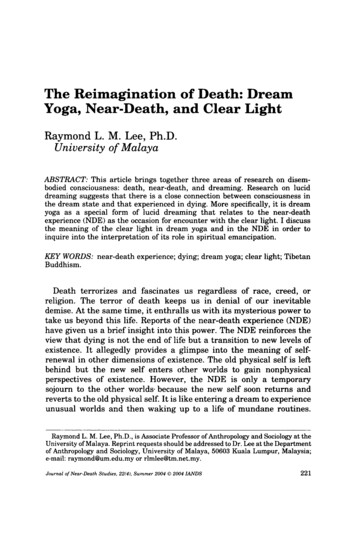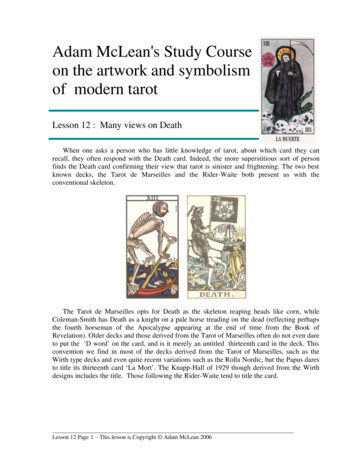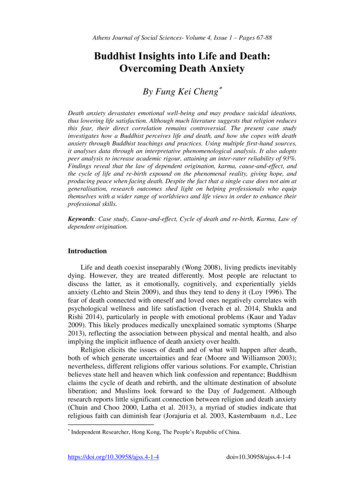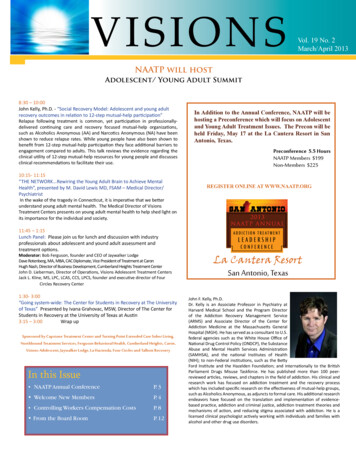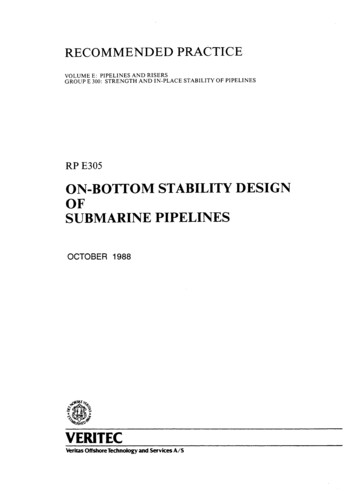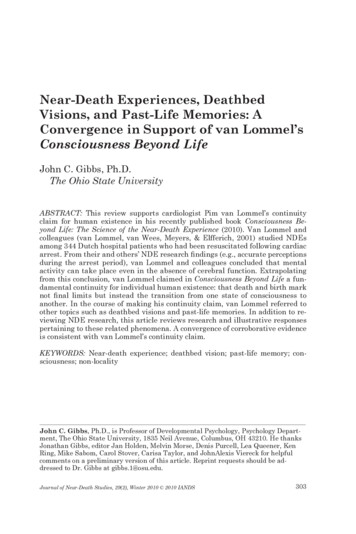
Transcription
Near-Death Experiences, DeathbedVisions, and Past-Life Memories: AConvergence in Support of van Lommel’sConsciousness Beyond LifeJohn C. Gibbs, Ph.D.The Ohio State UniversityABSTRACT: This review supports cardiologist Pim van Lommel’s continuityclaim for human existence in his recently published book Consciousness Beyond Life: The Science of the Near-Death Experience (2010). Van Lommel andcolleagues (van Lommel, van Wees, Meyers, & Elfferich, 2001) studied NDEsamong 344 Dutch hospital patients who had been resuscitated following cardiacarrest. From their and others’ NDE research findings (e.g., accurate perceptionsduring the arrest period), van Lommel and colleagues concluded that mentalactivity can take place even in the absence of cerebral function. Extrapolatingfrom this conclusion, van Lommel claimed in Consciousness Beyond Life a fundamental continuity for individual human existence: that death and birth marknot final limits but instead the transition from one state of consciousness toanother. In the course of making his continuity claim, van Lommel referred toother topics such as deathbed visions and past-life memories. In addition to reviewing NDE research, this article reviews research and illustrative responsespertaining to these related phenomena. A convergence of corroborative evidenceis consistent with van Lommel’s continuity claim.KEYWORDS: Near-death experience; deathbed vision; past-life memory; consciousness; non-localityJohn C. Gibbs, Ph.D., is Professor of Developmental Psychology, Psychology Department, The Ohio State University, 1835 Neil Avenue, Columbus, OH 43210. He thanksJonathan Gibbs, editor Jan Holden, Melvin Morse, Denis Purcell, Lea Queener, KenRing, Mike Sabom, Carol Stover, Carisa Taylor, and JohnAlexis Viereck for helpfulcomments on a preliminary version of this article. Reprint requests should be addressed to Dr. Gibbs at gibbs.1@osu.edu.Journal of Near-Death Studies, 29(2), Winter 2010 2010 IANDS303
304journal of near-death studiesPim van Lommel is a distinguished cardiologist, researcher, author,and lecturer with a particular interest in near-death experiences(NDEs). With colleagues (van Lommel, van Wees, Meyers, & Elfferich, 2001), he published in a major medical journal his longitudinalresearch on the correlates, contents, and aftereffects of NDEs. Fromthe results of this and other NDE studies, van Lommel concludedthat conscious mental activity can take place even in the absence ofcerebral function. Extrapolating from this conclusion, he asserted inhis new book Consciousness Beyond Life: The Science of the NearDeath Experience (2010) a profound existential and ontological claim:that human birth and death mark not final limits but instead transitions of the person from one state of consciousness to another. Is therea fundamental continuity to individual human existence?As van Lommel acknowledged, the continuity claim for humanexistence is “nothing new” (p. 82). The view of humans as having acontinuing, non-material essence has found advocates throughouthuman intellectual and religious history. The third-century neoPlatonist philosopher Plotinus posited that humans have souls thatoriginate from and return to a timeless, unitary realm of light andtruth. The continuity claim has also found expression in the worksof philosophers, theologians, and mystics such as Baruch Spinoza,Meister Eckhart, Paul Tillich, John Shelby Spong, and Kahlil Gibran.Reincarnation in particular has been thematic to Eastern religions ortraditions (Hinduism, Jainism, Tibetan Buddhism), ancient Egypt,most tribal traditions, Christian Gnosticism, Jewish mysticism,Norse mythology, and spiritualist literature such as that of theosophy and New Age.Van Lommel is also not the first to base the continuity claim onresearch findings in psychology and other disciplines. Transpersonalpsychologist Jenny Wade (1998) used NDE and ostensible prenatalmemories to suggest that a transcendent source of consciousness“predates physical life at the moment of conception and survives itafter death” (p. 249). Radiation oncologist Jeffrey Long (2010) concluded from a large online NDE self-report data base that “death isnot an end but a transition” to an afterlife (p. 201). Edward Kellyand colleagues (Kelly, Kelly, Crabtree, Gauld, Grosso, & Greyson,2007) argued the need for a twenty-first century psychology that canadequately accommodate many currently anomalous phenomena, including NDEs and deathbed visions. Their prototype toward a newpsychological paradigm retrieved the insights of two of psychology’sfounding figures, Frederick W. H. Myers and William James, and en-
john C. Gibbs305compassed contributions ranging from process theology to quantumphysics.Yet something importantly new pertains to van Lommel’s NDEresearch-based articulation of the continuity claim: in two words, TheLancet. The prior publication of his and colleagues’ (van Lommel etal., 2001) large-scale prospective longitudinal study of NDEs in thisprominent and prestigious medical journal renders his championingof the continuity claim particularly challenging to the mainstreamacademic and professional community.The challenge meets understandable opposition. How can van Lommel or anyone justifiably use near-death studies to make claims regarding death and beyond? It has been said that an extraordinary hypothesis requires for its acceptance extraordinary evidence—and thecontinuity hypothesis would certainly seem to be extraordinary. Hasnot neuroscience established that mind or consciousness is totally afunction of the brain—and hence cannot possibly continue once brainactivity has ceased? What evidence could be extraordinary enough tochallenge this established materialist view of mind qua brain—letalone support a leap into a claim for the existence of an afterlife? Doesnot such a claim drag scholars back to pre-scientific days of baselessbelief, dogma, and superstition?Yet as I will show, there is extraordinary evidence. And as the evidentiary base broadens, the existential and ontological claim becomescompelling. Although van Lommel (2010) based his continuity claimlargely on NDE studies, he referred also to related existential phenomena such as deathbed visions or “nearing-death awareness” aswell as past-life memories. Such related phenomena round out thepicture and merit more extensive attention than that afforded in vanLommel’s book alone. Accordingly, in this article I primarily reviewnot only NDEs but also deathbed visions and past-life memories (cf.E. F. Kelly et al., 2007). I will illustrate the experiential “feel” of thesephenomena as well as review corroborative and converging evidence.Near-Death ExperiencesFeatured in Consciousness Beyond Life are basic contents and after effects of NDEs, which van Lommel defined as “the (reported) recollection of all the impressions gained during a special state of consciousness” that “can occur during . . . a period of clinical death”(2010, p. 7). This special mental state entails “profound psychologicalevents with transcendent and mystical” qualities (Greyson, 2000b,
306journal of near-death studiesp. 316). These psychological events are experienced from an out-ofbody vantage point and can be categorized as material (perceptionof the ordinary phenomenal world, usually including seeing froman elevated vantage point one’s physical body and its surroundingearthly situation), and transmaterial (perceived activity beyond theordinary phenomenal world, such as movement through a dark region or void to an otherworldly, brighter realm; mentally communicating in that realm with a being or beings of light, deceased lovedones, or spiritual figures; reviewing events of one’s earthly life; andreaching some border, limit, barrier, or juncture) (Holden, 2009; cf.Sabom, 1982). In combined or comprehensive NDEs, the transmaterial aspect of the experience typically follows the material aspect“in a continuous, unbroken sequence” (Sabom, 1982, p. 52). As I willelaborate below, material, transmaterial, and especially comprehensive NDEs (cf. Sabom, 1982) can have major and long-lasting effectson the experiencer’s attitudes, beliefs, and behavioral lifestyle. Experiencers generally do not differ in demographic or psychological termsfrom non-experiencers (Fenwick & Fenwick, 1995; Greyson, 2000a;Holden, Long, & MacLurg, 2009; van Lommel, 2010).As have others, van Lommel (2010) noted that NDE basic featuresand aftereffects “appear to be the same worldwide except for someculture-specific differences in content and interpretation” (p. 11; cf.Kellehear, 2009). Culturally contextualized ways of describing or interpreting the dark region, for example, include: tunnel, current ofwind, narrow ravine, cave, well, trough, sewer, valley, and tube (Kellehear, 2009; Nahm, 2009). Whereas a rural Asian experiencer reportedhaving emerged through the calyx of a lotus flower, an American truckdriver recollected having been “shot through a tailpipe toward a brilliant light” (Cox-Chapman, 1995, p. 17) and an American child remembered moving through a noodle (Morse, 1999). Kellehear (2009)inferred that respondents from diverse cultures were “attempting todescribe some kind of movement through darkness” (p. 152) and intosome otherworldly, usually bright realm. Based on study of over 1,300cross-cultural reports (spanning over 110 countries) at his researchwebsite, Long (2010) concluded: “Whether it is a near-death experience of a Hindu in India, a Muslim in Egypt, or a Christian in theUnited States, the same core elements are present” (p. 149).Might this cross-culturally evident phenomenon be interpretable asmere hallucination or fantasy? After all, “the imagination can be madeto produce realistic images that can be projected outward as thougha part of the perceived world” (Blackmore, 1993, p. 69; cf. Whinnery,
john C. Gibbs3071997). If NDEs are simply fantasies, they certainly are remarkableones. Experiencers generally regard the experience as a distinctlyreal event in which they retained their personal identities. Thosewho remember their dreams or who have had hallucinations typicallydistinguish their NDEs as neither dream nor hallucination (Long,2010; Ring, 1980; Sabom, 1982). One respondent said, “It was too real.Dreams are always fictitious. This was me, happening at that timeand there was no doubt that it was reality” (Ring, 1980, p. 82). Somepatients even describe the experience as “realer than here” (Sabom,1982, p. 16; cf. Long, 2010). Intriguingly, unlike figures encounteredin dreams or hallucinations, figures encountered during NDEs arealmost always deceased (Long, 2010).It is noteworthy that these phenomenally “real” experiences canoccur during near-death. All of the 62 NDE (and 282 non-NDE) casesreported in van Lommel et al.’s (2001) study had been close to death.With the cooperation of 10 hospitals in the Netherlands, van Lommel’s research team interviewed these patients at several points following their resuscitations from cardiac arrest (as documented inelectrocardiogram records), that is, clinical death (loss of respirationand blood circulation with consequent brain anoxia). The loss of respiration and blood pressure precipitates the loss of cortical and evenbrain stem function (Sabom, 1998; van Lommel, 2010). The brain isshutting down.Could these phenomenally real perceptions be attributable, then,to disinhibitory effects of a dying brain or a brain under heavy medication (Blackmore, 1993; cf. Blanke, Ortigue, Landis, & Seeck, 2002)?The data do not support either attribution (Greyson, Kelly, & Kelly,2009). In contrast to the “disorganized” thought processes associatedwith neural disinhibition, the recollections of NDE survivors arewell-structured, lucid, and coherent (Parnia & Fenwick, 2002, p. 8;cf. Owens, Cook, & Stevenson, 1990). Nor is the NDE prevalence rateassociated with the administration of pharmacological agents. The27% of NDE respondents who had received “extra medication” during the cardiac arrest was comparable to the 25% of extra-medicationadministration among the non-NDE respondents (van Lommel et al.,2001, p. 2042; cf. Sabom, 1982).Moreover, the occurrence of any perceptual experiences duringclinical death—let alone lucid experiences—is difficult to explain.Although some undetected brain activity is possible during cardiacarrest, such “minute” activity “would be unlikely to lead to adequateelectricity being generated for the brain cells to communicate with
308journal of near-death studieseach other” (Parnia, 2006, p. 94; cf. Kelly, Greyson, & Kelly, 2007). Although near-death is of course not death per se, the cardiac standstill,brain nonfunction, and sensory shutdown in cardiac arrest represent“the closest model [we have] to the process of dying” (van Lommel,2006, p. 136; bracketed material added; cf. Parnia, 2006).The anomaly must be emphasized. If human consciousness is totally dependent upon brain neuronal network activity, as adherentsto the mainstream materialist view assume (see Tart, 2009), thenshould not the cessation of such activity preclude for all such individuals any psychological experience? And yet this extraordinary experience did occur for a substantial percentage (18) of van Lommel et al.’scardiac arrest patients, a rate within the range of 11–43% found inlongitudinal and retrospective studies (e.g., Greyson, 2007; Parnia etal., 2001; Ring, 1982; Sabom, 1980; Schwaninger, Eisenberg, Schechtman, & Weiss, 2002; see Zingrone & Alvarado, 2009).Suggestive of a transcendent significance to these experiences isvan Lommel et al.’s (2001) finding that the NDE becomes more likelyas death approaches. Among their patients, those who died soon—within 30 days—after their cardiac arrests were more likely to havehad an NDE: 21% versus 9% among matched controls. Even moreintriguingly, the dead-soon-after proportion rose to more than a third—from 21 to 43%—among those patients who had had a “deep” orextensive NDE (p. 2041). Van Lommel (2010) suggested that the patients who experienced a “deep” NDE may have been more disposedto “let go” and die (p. 143). Van Lommel et al. also found that, amongnear-death experiencers (NDErs) who recovered from their neardeath episodes, “deep” NDErs were more likely to report major lifechanging aftereffects. Yet van Lommel et al. (2001) did not replicateprevious findings (Ring, 1980; Sabom, 1982) linking NDE occurrenceto other indicators of closeness to physical death such as duration ofunconsciousness.To consider further materialist or fantasy vs. transcendent interpretations of this cross-culturally evident, phenomenally real, lucid,and sometimes “deep” experience, I turn now to the basic featuresand aftereffects of the NDE as described in Consciousness BeyondLife and other works.Core Features of Near-Death ExperiencesThe NDE contents reviewed in Consciousness Beyond Life entail bothmaterial and transmaterial perceptual referents. Many of the exam-
john C. Gibbs309ples were drawn from the van Lommel et al. (2002) study, in whichcontent recollections remained consistent across 1–30 days, 2 years,and 8 years following the near-death episode (cf. Greyson, 2007). VanLommel (2010) described 12 elements derived from Moody’s (1975)original list: ineffability; a feeling of peace and quiet (the pain hasgone); the awareness of being dead; an out-of-body experience; a darkspace (the “tunnel” experience); perception of an unearthly environment; meeting and communicating with deceased persons; perceptionof a brilliant light or being of light; a panoramic life review; a previewor flash forward; perception of a border; and return to the body.These elements relate to material and transmaterial core features(cf. Sabom, 1982). As the following account will show, aspects ofthese contents are difficult to account for by happenstance or common knowledge. I will devote particular attention to: (a) material orphenomenal-world perceptions that have been verified as accurate;and (b) certain NDE transmaterial or transcendent perceptions (deceased-person encounters, life review, border) that entail aspects difficult to explain by ordinary means.Accurate material perception. NDE respondents often report—sometimes with independent corroboration of details—that they per ceived their own bodies and environs from a position outside andtypically above their bodies. In some instances, they report havingseen persons or events in other locations. Reports indicating surprise,shock, or puzzlement seem particularly authentic (Gibbs, 1997). Anoncology hospice worker hospitalized for acute leukemia recollecteda sudden realization while scrutinizing a cardiac monitor hanging onthe wall above the head of her hospital bed:Oh, heart rate 200, 180, 200, blood pressure 40 over zero, and thingsare going off, and I’m thinking, “Wow, this person’s really in seriouscondition,” and then all of a sudden it dawns on me that moi [my body]is hooked up to this monitor! (Brown, 1994; cf. van Lommel, 2010, p.21; bracketed material added).After mentioning that “it took me a few moments to recognize myself,” another experiencer exclaimed:Boy, I sure didn’t realize that I looked like that! You know, I’m onlyused to seeing myself in pictures or from the front of a mirror, andboth of those look flat. But all of a sudden there I—or my body—wasand I could see it. I could definitely see it, full view, from about fivefeet away. (Moody, 1975, p. 39)
310journal of near-death studiesPatients may recollect perceiving not only their own body but alsosurrounding persons, objects, and events. Particularly challenging isthat many such perceptions—often of a highly specific and idiosyncratic nature—were subsequently corroborated as accurate by medical staff and others. In the van Lommel et al. (2001) study, a patientwho had remained deeply comatose and under artificial respirationfor days nonetheless upon recovering recognized the male nurse whohad removed his dentures to prepare him for intubation. He askedhim to return his dentures, correctly identifying their whereabouts(on a sliding shelf). He also accurately described details of the resuscitation room, the procedure, and the appearance of other staff members (p. 2041; cf. Smit, 2008a, Smit & Rivas, 2010). The fact that thedenture removal occurred during the comatose period—and that thestaff had not mentioned the removal—supports the inference thatthe patient’s perception occurred during the coma.The incident that van Lommel and colleagues reported is notunique. Researchers have reported many other cases of verified perceptual recollections from experiences apparently taking place during deep anesthesia or near-death conditions (Long, 2010), and highproportions of the reported details have been independently corroborated (Holden, 2009). A 7-year-old girl, despite having been deeplycomatose from having nearly drowned, nonetheless recalled idiosyncratic details of her emergency care such as her unusual intubation—nasal instead or oral. Much to her parents’ astonishment, she evenrecalled accurate details pertaining to her parents’ exact locations,clothing, and activities at home during her hospitalization (Morse,1990, p. 7). One respondent was baffled regarding his extraordinaryperceptual ability: “I just don’t understand how I could see so far”(Moody, 1975, p. 51; see also Farr, 1993, p. 25). Another recalled amoment of amazement as he was, during the experience,thinking about my family, and suddenly finding my energy at home inmy backyard, floating above the back porch and looking into the housethrough the kitchen window. There was a bird sitting on the windowledge. I was amazed that I could move so closely to it without its flyingaway (Ring & Valarino, 1998, pp. 15–16).Weiss (2000; cf. van Lommel, 2010, pp. 23–26) reported the corroborated recollection of an elderly—and blind—woman whosuffered a cardiac arrest during her stay in the hospital where I [Weiss]was the chairman of the psychiatry department. She was unconsciousas the resuscitation team tried to revive her. According to her later
john C. Gibbs311report, she floated out of her body and stood near the window, watching [the resuscitation]. She observed, without any pain whatsoever, asthey thumped on her chest and pumped air into her lungs. During theresuscitation, a pen fell out of her doctor’s pocket and rolled near thesame window where her out-of-body spirit was standing and watching. The doctor eventually walked over, picked up the pen, and putit back in his pocket. He then rejoined the frantic effort to save her.They succeeded.A few days later, she told her doctor that she had observed theresuscitation team at work during her cardiac arrest. “No,” he soothingly reassured her. “You were probably hallucinating because of theanoxia [lack of oxygen to the brain]. This can happen when the heartstops beating.”“But I saw your pen roll over to the window,” she replied. Then shedescribed the pen and other details of the resuscitation. The doctorwas shocked. His patient had not only been comatose during the resuscitation, but she had also been blind for many years. (pp. 169–170;bracketed material added)In a later publication, Weiss (2004) noted that “the cardiologistwas still shaken days later when he told me [Weiss] about it. He confirmed that everything the woman related had indeed taken placeand that her descriptions were accurate” (p. 10). Other cases of verified perceptual recollection by near-death survivors blind since birthhave also been reported in the literature (Ring & Cooper, 1999).In yet another case, a surgery patient under anesthesia and drapedabove the neck subsequently described leaving his body and watchingthe cardiac surgeon “flapping his arms as if trying to fly.” The surgeonverified this description of his movements, explaining that in an effort to prevent contamination after scrubbing in, he directed staff inthis way (Cook, Greyson, & Stevenson, 1998, pp. 399–400). A medicalcolleague of the surgeon’s was exasperated: “So explain that to me.Explain that, through chemicals or some other [materialist] scientificexplanation. Please explain to me why that man knows that” (Ling,2008; bracketed material added).Besides the denture removal incident in their own study, van Lommel and colleagues in the Lancet article—and van Lommel in Consciousness Beyond Life—refer to a case of veridical perception duringa thoroughly documented near-death condition, namely, the case ofPam Reynolds (a pseudonym) (Sabom, 1998). Reynolds’ comprehensive NDE occurred during six hours of major surgery that involvedan hour of induced hypothermia with cardiac arrest. The surgery’saim was to remove a brain aneurysm so large as to be inoperable by
312journal of near-death studiestraditional procedures. Excision of the giant aneurysm required itscollapse—“like a deflated balloon” (Sabom, 1998, p. 45)—as the bloodin the arteries of the brain, and indeed the entire body, was drained“like oil from a car,” cooled, and temporarily stored in a machine(p. 43). Reynolds’ eyes were taped shut, ear canals occluded with fitted earplug “speakers” that emitted a rapid clicking noise for brainmonitoring purposes, and body deeply anesthetized. Eventually, asher body temperature lowered and blood drained from her body, herheart stopped beating and her brain ceased electrical activity.Not yet in induced hypothermia, although already under deep anesthesia as her skull was incised, she recollected leaving her body and“looking down”:I [Reynolds] was the most aware that I think I have ever been in myentire life. . . . I was metaphorically sitting on Dr. Spetzler’s shoulder.It was not like normal vision. It was brighter and more focused andclearer than normal vision. (p. 41; cf. Long, 2010)Reynolds reported that, from her elevated vantage point, she perceived numerous details, such as the pitch and shape of the cranialsaw, her partially shaven head, and an assisting surgeon’s commentregarding the small size of her left-groin blood vessels—all of whichwere later corroborated by the medical staff. The recollection cannot be explained as fabricated from pre- or post-perceptions, giventhat the surgery room objects were not initially or post-operativelyin view. Reynolds’ surgeon, Robert Spetzler, found Reynolds’ accurate recall “incredibly perplexing” (Benz, 2001). He explained: “Thedrill and so on, those things were. . . . in their packages. You reallydon’t begin to open until the patient is completely asleep so that youmaintain a sterile environment” (Broome, 2002; cf. Smit, 2008b; Smit& Rivas, 2010; but see also Woerlee, 2010). Also, the assisting surgeon’s comment concerning Pam’s blood vessels occurred well into theprocedure.Reynolds’ accuracy corroborates an earlier finding by Sabom (1982;cf. Holden, 2009) of veridicality in near-death experiences. Beforestudying the phenomenon, Sabom had been convinced that the “neardeath experience, if properly studied, could be reduced to a simplescientific explanation” (p. 175). At the onset of his first NDE study ofhospital patients, Sabomwas anxiously awaiting the moment when a patient would claim thathe had “seen” what had transpired in his room during his own resuscitation. Upon such an encounter, I [Sabom] intended to probe meticulously for details that would not ordinarily be known to nonmedical
john C. Gibbs313personnel. In essence, I would pit my experience as a trained cardiologist against the professed visual recollection of lay individuals. . . . [Inso doing,] I was convinced that obvious inconsistencies would appearwhich would reduce these purported “visual” observations to no morethan “educated guesses.” (p. 83; bracketed material added)Sabom interviewed 32 such patients. All of their accounts of hospital CPR procedure were accurate, including six particularly detailedrecollections. The recollected details in each case were “fairly specificfor the actual resuscitation being described and . . . not interchangeable with the clinical circumstances of other near-death crisis events”(p. 114). One patient did make apparent errors in describing the operation of a defibrillating meter—but then Sabom, to his astonishment, discovered that that description matched an older model thatwas “still in common use in 1973, at the time of [the patient’s] cardiac arrest” (p. 104). Given a traditional medical training similar toSabom’s, van Lommel (2010) was also “more than a little surprised”by his patients’ reported NDEs (p. vii).To establish a baseline rate of accuracy attributable to educatedguesses, Sabom also interviewed a control group of 25 patients withcomparable cardiac-related background and hospital experience butwho had not reported an NDE. It should be noted that only 4 amongthe 25 control group patients had actually been resuscitated fromcardiac arrest (Blackmore, 1985; cited in Holden, 2009). These 25patients were asked what they would expect to see if they were towatch a hospital CPR procedure. The baseline rate of accuracy waslow: Many (21) participants made at least one “major error” (p. 85) intheir descriptions.Consistent with Reynolds’ and others’ verified perceptions, then,the accuracy rate of the group reporting specific recollections wasoverwhelming and not readily attributable to projections from common knowledge. Such findings of accurate out-of-body perception haveprompted a major collective (multi-hospital) effort to “test the reportsof being able to see from above during a cardiac arrest through a technological refinement using random images that will only be visiblefrom an elevated vantage point” (Parnia, 2006, p. 162). This projectwas still in progress as of the end of 2010.Encounters with deceased persons. Recollected NDE perceptionsmay pertain not only to material but also to non-material or transcendent referents such as those involved in encountering a being of lightor deceased persons, often close relatives, with whose thoughts and
314journal of near-death studiesfeelings the NDErs “feel a strong connection” (van Lommel, 2010,p. 33). It is intriguing that child NDE survivors whose potentiallycomforting parents were present and highly salient nonetheless generally report having encountered such deceased loved ones (Greyson,2000b; Long, 2010). Also intriguing is that these deceased figuresseem to evidence a surprising or unexpected independence in theirapparent role as guides or protectors. Pam Reynolds’ relatives “in thelight” would not “permit [her] to go further” (Sabom, 1998, p. 44). Al though Reynolds expected her grandmother to escort her on her return, her grandmother “just didn’t think she would do that.” Reynolds’ uncle instead escorted her and facilitated her return (Sabom,1998, p. 46).As noted, expressions of surprise or perplexity suggest an authenticity to NDE reports. An experiencer named Elinor remembered thatherfather loved having friends and family around. The fact that it stillseems odd to Elinor that her father would have turned down her company [“All he said to me was, ‘Sweetheart, don’t come’”] gives credenceto the possibility that her vision is not simply a construct of her imagination. (Cox-Chapman, 1995, p. 134)Another experiencer, a woman who had nearly died from sinus infection complications, also experienced surprise at the behavior of afigure she encountered. She recalled suddenly leaving her body andfeeling “overjoyed to see” the much-beloved pastor of her church:But he seemed very upset and had a very worried face and began waving his arms around, and he was just acting frantic. So I said, “Aren’tyou glad to see me? I’ve missed you so much since you died last summer!” And then it hit me, and I said, “If you’re dead and I’m here withyou, then . . .” And he started nodding his head frantically. Just assuddenly, I slammed back into my body. (NDE archives, 2003)Particularly challenging to ordinary explanation are encounterswith figures whose death is only subsequently r
memories to suggest that a transcendent source of consciousness “predates physical life at the moment of conception and survives it after death” (p. 249). Radiation oncologist Jeffrey Long (2010) con-cluded from a large online NDE self-report data base that “death is not an end but a transition


